The Leibniz-IZW is an internationally renowned German research institute. It is part of the Forschungsverbund Berlin e.V. and a member of the Leibniz Association. Our goal is to understand the adaptability of wildlife in the context of global change and to contribute to the enhancement of the survival of viable wildlife populations. For this purpose, we investigate the diversity of life histories, the mechanisms of evolutionary adaptations and their limits, including diseases, as well as the interrelations of wildlife with their environment and people. We use expertise from biology and veterinary medicine in an interdisciplinary approach to conduct fundamental and applied research – from the molecular to the landscape level – in close dialogue with the public and stakeholders. Additionally, we are committed to unique and high-quality services for the scientific community.
+++ Current information on African swine fever: The Leibniz-IZW conducts research on the population dynamics, on models of disease outbreaks in wild boars and on the ecology and human-wildlife interaction in urban areas. African swine fever is a reportable disease in domestic swine and therefor is the purview of the respective federal state laboratories and the Friedrich-Loeffler-Institut (Federal Research Institute for Animal Health) FLI. +++
News
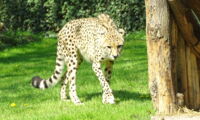
Early first pregnancy is the key to successful reproduction of cheetahs in zoos
Cheetah experts in many zoos around the world are at a loss. Despite all their efforts, these cats often do not reproduce in the desired manner. Researchers from the Leibniz Institute for Zoo and Wildlife Research (Leibniz-IZW), together with colleagues from the Allwetterzoo Münster, have now found a key to the issue: the age of the mothers at the first pregnancy is the decisive factor. In contrast to the wild, felines kept in zoos are often bred only years after they have reached sexual maturity. From the study results, the researchers derive recommendations for keeping cheetahs in zoological gardens. The study was published in the journal "Journal of Zoo and Aquarium Research".
Read more … Early first pregnancy is the key to successful reproduction of cheetahs in zoos
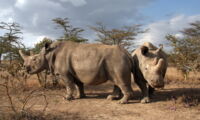
Last chance for the Northern White Rhinoceros: German Federal Ministry of Education and Research supports high tech for conservation with the BioRescue project
Today the research project BioRescue for the rescue of the Northern White Rhino, which is threatened with extinction, is officially launched. State-of-the-art reproduction and stem cell technology shall ensure the survival of this key species. The international scientific consortium, led by the Leibniz Institute for Zoo and Wildlife Research (Leibniz-IZW) and with the significant participation of the Max Delbrück Center for Molecular Medicine (MCD), is receiving around 4 million Euros in funding from the Federal Ministry of Education and Research (BMBF) as part of the BMBF's biodiversity conservation research initiative. With the successful transfer of an embryo into the uterus of a Southern white rhinoceros at the end of May 2019, the research team has already reached an important milestone. The ethical and social questions arising from BioRescue will be addressed by the scientists in an accompanying research project.
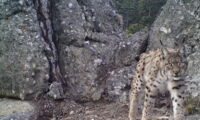
Noninvasive techniques help clarify conservation relevant aspects of population structure and organization in the Caucasian lynx in Turkey
Little is known about the biology and the genetic status of the Caucasian Lynx (Lynx lynx dinniki), a subspecies of the Eurasian lynx distributed across portions of Turkey, the Caucasus region and Iran. To collect baseline genetic, ecological, and behavioural data and assist future conservation efforts, a team of scientists from the Leibniz Institute for Zoo and Wildlife Research (Leibniz-IZW) collected data and samples in a region of Anatolian Turkey over several years. They were particularly interested in the question whether non-invasive samples (faeces, hair) were helpful to discern genetic diversity of the study population. The results of the genetic analyses indicated an unexpectedly high genetic diversity and lack of inbreeding despite the recent isolation of the study population, a result that would not have been obtained with the use of conventional samples. The data also revealed that females stay near home ranges in which they were born whereas males disperse after separation from their mothers. These insights into the genetics and behaviour of the Caucasian Lynx are published in the scientific journal PLoS ONE.
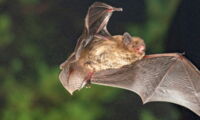
Mirror experiment proves that compass orientation of a migratory bat species depends on sunset direction
Whether it is bats, wildebeest or whales, millions of mammals move over thousands of kilometres each year. How they navigate during migration remains remarkably understudied compared to birds or sea turtles, however. A team of scientists led by the Leibniz-IZW in Berlin now combined a mirror experiment simulating a different direction of the setting sun and a new test procedure to measure orientation behaviour in bats to understand the role of the sun’s position in the animals’ navigation system. The results demonstrate for the first time that a migratory mammal species uses the sunset direction to calibrate their compass system. Furthermore the experiment, which is published in “Current Biology”, indicates that this capacity is not inherited and first-time migrating young bats need to learn the importance of the solar disc at dusk for nightly orientation.
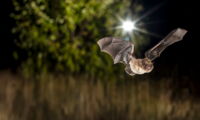
A complex relationship: How light from street lamps and trees influence the activity of urban bats
Berlin, 27.03.2019
Artificial light is rightly considered a major social, cultural and economic achievement. Yet, artificial light at night is also said to pose a threat to biodiversity, especially affecting nocturnal species in metropolitan areas. It has become clear that the response by wildlife to artificial light at night might vary across species, seasons and lamp types. A study conducted by a team led by the Leibniz Institute for Zoo and Wildlife Research (Leibniz-IZW) sheds new light on how exactly ultraviolet (UV) emitting and non-UV emitting street lamps influence the activity of bats in the Berlin metropolitan area and whether tree cover might mitigate any effect of light pollution. The study is published in the scientific journal “Frontiers in Ecology and Evolution”.
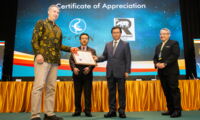
Back to Nature: for the first time palm oil plantations are being turned back into protected rainforest – this creates a corridor for Borneo’s endangered wildlife
Kota Kinabalu, Malaysia, 21.03.2019
Scientists in collaboration with Borneo‘s forestry authorities want to turn palm oil plantations into rainforests. Lessons learned from this project can then be used as a blueprint for future reforestation projects. The pilot project will be led by the Rhino and Forest Fund (RFF). At the Heart-of-Borneo- Conference, the RFF will receive an award from the Malaysian government of Sabah for its achievements to date.
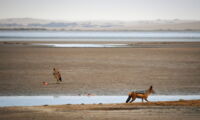
Eating the flu: diet may be an important factor for Influenza A virus exposure in wild African mammals
Given the importance and wide distribution of Influenza A viruses, it is surprising how little is known about infections of wild mammals. A new study led by Alex D. Greenwood and Gábor Á. Czirják of the Leibniz Institute for Zoo and Wildlife Research (Leibniz-IZW) in Berlin sheds light on which species are commonly infected and why. The scientists detected virus exposure among wild African mammals in Namibia and demonstrated that the most important factor for influenza A virus diversity and prevalence is a diet containing birds. Species relationship or sociality play surprisingly small roles. The results have been published in “The Journal of Infectious Diseases”.
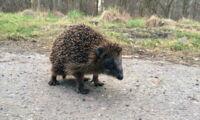
Prickly neighborhood: A team of scientists provided first evidence of diphtheria-like infectious agent in hedgehogs
As cultural successors, hedgehogs reside in close proximity to humans. Close contacts, however, are not only beneficial but also bear risks for animals and humans. Road traffic, lawn mowers and infectious agents threaten the prickly insect eaters. Some infectious agents can be transmitted to humans. Considerate treatment of wildlife and appropriate hygiene measures minimize the risk of infection, though. A recent study, initiated by the National Consiliary Laboratory for Diphtheria (CL-Diphtheria) in Germany and conducted in close collaboration of five federal state laboratories and the Leibniz Institute for Zoo and Wildlife Research (Leibniz-IZW), identified Corynebacterium ulcerans - a close relative of the diphtheria causing bacterium - in hedgehogs. The study is published in „Emerging Microbes & Infections“.




